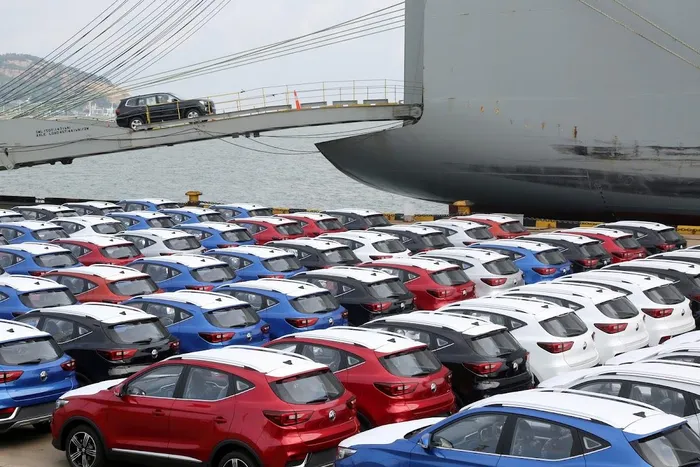South Africa's automotive industry braces for potential US export tariffs
AUTOMOTIVE

The Automobile Business Council (Naamsa) on Tuesday said vehicle exports increased by 2 647 units year-on-year to 36 343 units exported in June from the 33 696 units exported during the same month last year
Image: Supplied
South Africa’s automotive industry has expressed anxiety about the potential impact of the impending export tariffs from the United States after vehicle exports rose by 7.9% in June, despite the growing toll of geopolitical and trade-related disruptions.
The Automobile Business Council (Naamsa) on Tuesday said vehicle exports increased by 2 647 units year-on-year to 36 343 units exported in June from the 33 696 units exported during the same month last year.
The automotive industry contributes 5.2% to South Africa’s gross domestic product (GDP), 3.2% in manufacturing and 2.01% retail.
In 2024, the export of vehicles and automotive components reached a record amount of R268.8 billion, equating to 14.7% of South Africa’s total exports.
Vehicles and components are exported to 155 international markets.
However, Naamsa noted with anxiety that trade-related uncertainty looms large as the 90-day reciprocal trade reprieve extended by the US is scheduled to expire next week.
Naamsa CEO Mikel Mabasa said that while the reprieve did not explicitly apply to Section 232 tariffs on automotive products, it formed part of the broader negotiation framework that will be critical in determining South Africa’s continued preferential access to the US market.
As such, Mabasa said ongoing engagement and negotiation over automotive exports will be vital to protect the sector’s long-term trade position and export earnings.
“South Africa’s automotive industry has long relied on a thriving export engine to sustain production volumes and attract investment,” Mabasa said.
“However, the current trade policy shifts, particularly from the United States, pose a real challenge to this model. To address this, our response must be strategic: diversifying markets, expanding regional trade, and continuing to advocate for fair and rules-based global trade systems.”
According to data from Naamsa, the new vehicle sales demonstrated unwavering domestic momentum in the first half of 2025, closing this period strong.
Aggregate new vehicle sales climbed once again by 18.7% or 7 444 to reach 47 294 units in June from the 39 850 units sold in June 2024 - reflecting a sustained and broad-based recovery in consumer and fleet demand.
This was in line with Naamsa’s earlier projection for a robust domestic performance in the first half of 2025.
For the first half of the year new vehicle sales were now 13.6% ahead of the corresponding period 2024, supported by and large by an influx of affordable imported models.
For the year-to-date [January to May 2025], Naamsa said new light vehicle imports by the Original Equipment Manufacturers (OEMs) increased by 25.6% and by the independent importers by 33.4% compared to the corresponding period 2024.
Brandon Cohen, national chairperson of the National Automobile Dealers’ Association, said the majority of the growth was centred in the sub-R400 000 segment.
“This price point remains critical for volume, affordability and trade-ins, with a direct knock-on effect on pre-owned sales performance. The used vehicle market is benefiting from improved affordability metrics, driven by softened interest rates, favourable vehicle pricing, and the rollout of the two-pot retirement savings reform,” Cohen said.
The upbeat performance in domestic new vehicle sales builds on gains since the fourth quarter of 2024.
Mabasa said this success was underpinned by a combination of favourable economic fundamentals. These include decreasing interest rates following the South African Reserve Bank’s further 25 basis points cut in May, a still-benign inflation backdrop, and improved credit access across the market.
“The first half of 2025 has shown just how resilient and responsive our domestic market truly is. Strong consumer demand, supported by positive economic fundamentals, has helped the automotive sector deliver impressive growth amid global turbulence,” Mabasa said.
However, the current market is only 1.5% ahead and 2024 volumes were 14% lower in the same month compared to June 2023.
Lebo Gaoaketse, head of marketing and communication at WesBank, said while new vehicle sales continue to build momentum, the overall market growth was clouded in the greater context of having merely returned to pre-COVID-19 levels.
“If the economic outlook remains favourable for further interest rate cuts, the new vehicle market should be expected to continue this momentum for the remainder of the year,” Gaoaketse said.
“More reassuring is the level of stability in the market – even at these heightened levels – which provides much more certainty for the industry, dealers and consumers alike.”
Looking ahead, Naamsa said the second half of 2025 will see the industry navigate a more complex environment.
BUSINESS REPORT